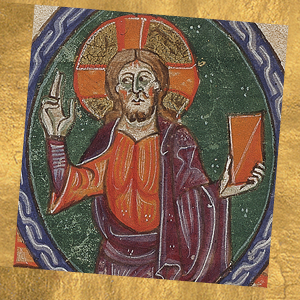St. Charles Borromeo, Archbishop of Milan and Cardinal

Looking out over the shores of Lago Maggiore, one sees it immediately: the statue of St Charles Borromeo, which dominates the shoreline of Arona. The 35-meter-tall statue, cast in bronze and iron in the 17th century, portrays the Archbishop of Milan in the act of blessing. But beyond that, there is a particularity about the monument: one can go inside it, climbing the staircase to the top of the statue. From that vantage point, one can look through the eyes of St Charles. The ability to see the world through his eyes, through the eyes of charity and humility is part of the lasting spiritual legacy of St Charles Borromeo.
From “boy bishop” to “giant of sanctity”
The life of St Charles Borromeo can be seen to run between the two poles of “boy bishop” and “giant of sanctity,” in a period of time that corresponded to his pastoral action.
The young Charles progressed quickly, even as a child. He was born in Arona in 1538, the second son of Gilbert and Margaret. At the age of 12 he was given the title of “commendatory” of a nearby Benedictine Abbey. The honorific title came with a notable income, but the future Saint insisted on dedicating the revenue to charity, especially the care of the poor.
The Council of Trent
Charles studied canon and civil law in Pavia, and in 1559, at the age of 21, became a doctor in utroque jure, “of both laws.” Several years later, his older brother, Federico, died. Many people counselled him to leave the ecclesiastical state, and take up his position as head of the family. Charles, however, decided to continue along the path to priesthood, and was ordained in 1563, at the age of 25. Shortly thereafter, he was consecrated Bishop, and he was able to participate in the final stages of the Council of Trent, becoming one of the principle promoters of the Catholic Reform (known historically as the “Counter-Reformation”). Later, he collaborated on the production of the Catechism of the Council of Trent.
Archbishop of Milan at age 27
Putting into practice the indications of the Council, which compelled Bishops to reside in their Dioceses, Charles took possession of the Archdiocese of Milan in 1565, when he was only 27. His dedication to the Ambrosian Church was total: he made a pastoral visitation of the whole of the Archdiocese three separate times, and organised the territory into ecclesiastical circumscriptions. He founded seminaries for the formation of priests; built churches, schools, colleges, and hospitals; instituted the Congregation of Oblates, composed of secular priests; and donated his own family’s wealth to the poor.
“Souls are won on one’s knees”
At the same time, Charles was dedicated to a profound reformation of the Church’s interior life: in a particularly sensitive time in the life of the Church, the young Bishop was not afraid to defend the Church against the encroachments of the powerful; and he was not lacking in the courage necessary to renew ecclesial structures, correcting abuses wherever he found them. Understanding that the reform of the Church, in order to be credible, must begin with her Pastors, Borromeo encouraged priests, deacons, and religious to believe in the strength of prayer and penance, transforming their life into a true path of sanctity. “Souls,” he often repeated, “are won on one’s knees.”
“Pastors must be servants of God and fathers to their people”
His pastoral ministry, stimulated by his love of Christ, nonetheless met with hostility and resistance. One group, the so-called “Humiliati” – a doctrinally suspect religious order – organised an attempt on his life. While praying in his chapel, the future Saint was shot at with an arquebus; however, the bullet failed to penetrate his vestments, and his life was saved. This was considered a miracle, and Charles was able to continue his mission because, as Pope Francis said, “he wanted Pastors who would be servants of God and fathers to their people, especially the poor” (Address to the Community of the Pontifical Lombard Seminary in Rome, 25 Jan 2016).
The plague strikes Milan
In the 1570’s Milan was struck by a plague; suffering from disease and famine, the Milanese people could rely only on their Archbishop. And Charles did not spare himself: faithful to his familial and episcopal motto Humilitas (“humility”), he visited and comforted the sick during the plague years of 1576 and 1577, spending all his wealth for their care. His presence among the people was so constant that this period would go down in history as “the plague of St Charles,” and in future ages, the great Italian novelist would speak of it in his masterpiece, I Promessi Sposi (“The Betrothed”).
Pilgrimage to the Shroud
The Archbishop of Milan also played an important role in bringing the Holy Shroud to Italy. It was in response to his intense desire to pray before the Shroud that the Duke of Savoy, in 1578, decided to bring the burial cloth of Christ from Chambéry, in France, to Turin, where it has remained ever since. St Charles made the pilgrimage to Turin on foot, praying and fasting over the course of four days.
Burial in the Duomo of Milan
However, after many years of labour, Charles Borromeo’s health began to fail; and in November 1584, the great Archbishop died, aged 46 years. He left a lasting moral and spiritual legacy. Charles was beatified in 1602 by Pope Clement VIII, and eight years later was canonized by Pope Paul V. Since that time, his relics have been venerated in the crypt of the Cathedral of Milan, in the so-called “Scurolo,” with scenes from his life portrayed in silver foil panels along the walls.








